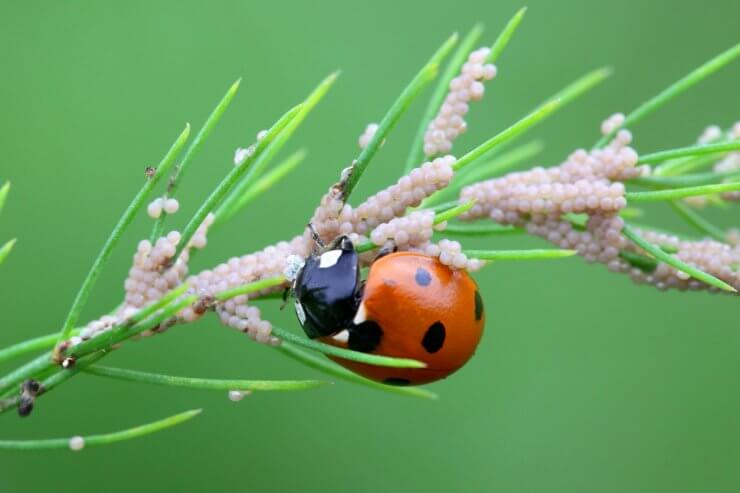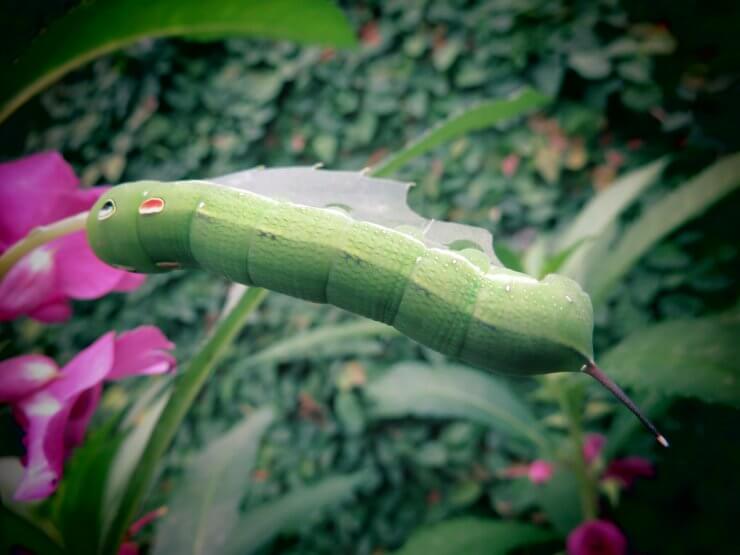
Ladybugs help asparagus by feeding on aphids and moth eggs
Pests in your asparagus patch, left unchecked, can damage and destroy your precious asparagus plants. Keeping a close watch on your plants during regular daily inspections will help you spot any pests before they can do irreparable harm. Healthy asparagus plants can bounce back from pest damage if you catch the pests quickly.
Spot the symptoms of asparagus plant pests
Check leaves, stems, and fruit for these symptoms that come from pests on the prowl!
On Asparagus Leaves and Stems
| Symptom | Pest | Treatment |
| Shriveled, dwarfed stems | Asparagus aphid | Introduce natural predators |
| Gnawed buds, blackened plant | Asparagus beetle | Introduce beneficial predators (ladybugs, soldier bugs); knock larvae onto the soil |
| Brown streaks | Asparagus miner | Pull and destroy affected spears at end of season |
| Profuse silk webbing on young plants | Beet armyworm | Pick off |
| Broken or chewed stems and leaves | Cutworms | Circle individual plants with metal or cardboard collars |
How to treat pests on asparagus plants

The beet armyworm is a prolific pest for asparagus
Here are some proven ways to get rid of pests on your asparagus plants. Choose the best treatment for the type of pests invading your plants.
- Pick off the pests. Use your garden gloves to remove the pests by hand. After removal, destroy pests by drowning them in a bucket of soapy water or crushing them with your foot. Handpicking isn’t efficient or practical for very small pests but works well with larger pests such as beetles.
- Apply insecticidal soap. Insecticidal soap is organic. The potassium salts in insecticidal soap help remove an insect’s protective waxes, causing destruction of insect membranes and killing them. Mix the soap with water to create your solution and apply directly to insects on any plants. While insecticidal soap is less apt to affect other organisms, certain plants might be sensitive to the soap and can suffer leaf burn.
- Apply horticultural oils. Combine plant- or petroleum-based oils with water to produce horticultural sprays. Neem oil, for instance, is derived from seed extracts of the neem plant. Oil-based sprays block an insect’s air holes, interfere with an insect’s metabolism, disrupt insect feeding, and inhibit insect growth. Like insecticidal soaps, horticultural oils can cause plant injury if not properly diluted.
- Make your own pest spray. You can make your own pest spray with benign materials. Mix one tablespoon of baking soda, 1/2 teaspoon of a mild dish detergent, and 2 1/2 tablespoons of olive oil in a gallon of water to make a solution that will repel all kinds of bugs, as well as a fungicide for blight and mildew on the asparagus plant leaves. Shake it well in your bottle before spraying and repeat every week for it to be continuously effective.
Do pests attack your asparagus plants every year? How do you handle removing them—and even preventing them in the first place? Please tell us how you treat your asparagus plants to avoid pests.


 Previous
Previous

